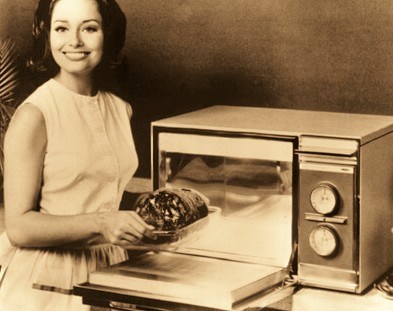Like so many things in life, our humble household appliances are something we only truly realize how much we depend on when something goes wrong! Humming away quietly in the background, keeping our food from spoiling, our clothes clean and our dinners hot, these little workhorses often have a fascinating history behind them – and here we share some of their stories!
The Microwave
While we may still think of the microwave as a pretty recent invention, its story actually begins way back in 1945 – and like many great inventions, the discovery of the scientific phenomenon behind it was a complete accident.
American engineer Dr. Percy Spencer was researching active combat radar, when he noticed that the chocolate bar he had in his pocket has started to melt. He theorized that the magnetrons responsible for producing these small wavelength electromagnetic waves (or ‘micro’ waves) could be used to heat and cook food.
Raytheon RadaRange circa 1961
So was born the first microwave oven – the ‘RadaRange’ – but it was far too large (6 feet tall and weighing in at 750 pounds) for home use, and besides – people were understandably still a little nervous of the harmful effects of radiation!
In 1967, the Amana Corporation introduced the first countertop microwave oven, and when Sharp came out with affordable models in the 1970s, they started on their path to becoming the kitchen staples they are today.
The Refrigerator
Since the very earliest days of human history, we’ve been seeking ways to keep our food fresher for longer. And indeed, the earliest experiments with refrigeration technology date back to the late 18th century.
American inventor Oliver Evans first suggested the use of a vapor-compressor (which would create ice by the placement of ether within a vacuum) to form the basis of a refrigeration device in 1805; but it wasn’t until 1914 that Nathaniel B. Wales designed the first electric refrigerator for domestic use which would become the basis of the Kelvinator.
Unfortunately – there was a problem. Early refrigerators could leak sulfur dioxide, methyl chloride and ammonia – sometimes with fatal effects. In the 1920s, three companies (Frigidaire, General Motors, and DuPont) joined forces and created Freon, a non-toxic alternative.
But wait for it… Freon is a chlorofluorocarbon – or CFC – and as we now know, incredibly harmful to the ozone layer, which protects the planet against ultraviolet radiation from the sun. Since 1994, the use of Freon in new refrigerators and air conditioning units has been banned, and we now generally use tetrafluoroethane (R-134a) in its place.
There’s little doubt that these refrigerating devices are some of the appliances we depend on the most, as we can put our health in jeopardy from consuming spoiled food when they aren’t working as they should. Luckily, there are now excellent fridge and freezer repairs specialists on call 24/7 to help out in a hurry.
The Dishwasher
Romanian stamp honoring Josephine Cochrane, inventor of the first dishwasher
Allegedly inspired by her frustration with servants chipping her fine china when they washed it, fiery socialite Josephine Cochrane of Shelbyville, Illinois, is credited with the invention of the first hand-powered dishwasher, which she created with help from mechanic George Butters in her tool shed!
Her invention was first unveiled at the 1893 World’s Fair in Chicago, and in 2006, she was posthumously inducted into the National Inventors Hall of Fame for her work.
The Vacuum Cleaner
Some of the earliest vacuum cleaners –such as British engineer Hubert Cecil Booth, and American inventor David T. Kenney’s models in 1901– were so large that they had to be brought round to your house on a horse-drawn cart, which was a little ironic, seeing as they were actually powered by an internal combustion engine!
The first portable vacuums suitable for home use followed pretty soon after, such as the snappily named “Griffith’s Improved Vacuum Apparatus for Removing Dust from Carpets”, (yikes!) built by Walter Griffiths of Birmingham, England, in 1905. His device looked rather similar to modern-day hose vacuum cleaners, with a flexible hose and variety of nozzle attachments – except for the inclusion of a ‘bellows-like’ device which the operator would have to compress.
Since then, we’ve seen the arrival of wet/dry vacuum cleaners, upright vacuums, handheld devices like the famous DustBuster, cyclonic, pneumatic and backpack versions to name but a few. Most recently, the arrival of robotic carpet sweepers like the Roomba who can empty and recharge themselves have perhaps ushered in a new era for the humble vacuum cleaner. In 2009, Neato Robotics launched a model which uses lidar (a rotating laser-based range-finder) to map out its surroundings, and even return to areas it wasn’t able to reach before – because the family cat was napping there, for instance.
In 1884, the espresso machine was invented by Angelo Moriondo, since then people have been going for the dark brew to wake up their brains. Here is a guide on how to make the perfect espresso.

